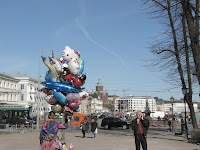This is something that has to be written in capital letters. What - A - Place….!!! Even at six in the morning...remember? We had to put the clock two hours back, so many-a yawning in the mawning. However, the sheer splendour of the city is better than a triple espresso, no doubt.
Brings the poor Blog guy in trouble, though: It is an impossible task to resume everything there is to say about this history-loaden playground of Czars and Emperors, Artists and famous people. Even more as our guides were not only excelling in the necessary languages, but also so very much overflowing of information only a tape recording would do the trick. Which we don't have.
So what about me just presenting a caleidoscope of images, this time with a nice caption each? Anyway, St. Petersburg is visual, bursting with amazing sights, Imperial architecture of dimensions that feels like it dwarfs us. On top of it all is bathed in clear spring sunlight, luring everybody out in the streets, including the many, many wedding couples that swarm out for pictures in front of the most memorable monuments, or the many soldiers that had a rehearsal for the grand parade of May 9.
So, here it comes, follow us through museums filled with world-class collections, across giant squares and to gargantuan statues, put in the middle of them. Enjoy!
 |
| The cupola of the St. Isaacs Cathedral, 4th cathedral ever buildt. Since gildening involved the use of mercury at the time, many workers died in the process. |
 |
| The Hotel Astoria, one of the oldest buildings in town. Rumor has it, that Hitler wanted to celebrate his victory here and had already the invitations printed. Luckily, it didn't work out... |
 |
| The red granite pillars of the Isaac Cathedral, each of them weighing 114 tons |
 |
| Every uniform in town rehearses for the big day, May 9,... |
 |
| ...whereas every newly wed couple seeks out the best backdrop for their pictures,... |
 |
| ...one of them surely being the Peter-and-Paul fortress, namesake of the city (Peter-Burg) |
 |
| The spire is the highest in St. Petersburg |
 |
| Remains of unforgettable moments? |
 |
| Champagne is indeed heavily involved at these occasions, it just loosens you up a little, right?... |
 |
| Church of the Savior on Blood |
 |
| Alexander Column, erected after the victory over Napoleon. 600 tons heavy, it literally sits in the middle of palace square, unsupported. |
 |
| Building of the General Staff at Palace Square, double-arched creation of Italian architect Carlo Rossi |
The following images take you to the incredible collections of the Hermitage, the "Winter Palace":
 |
| A 16-ton bowl, made of Jasper |
 |
| One of the many Imperial Corridors |
 |
| Every detail is worth looking at, e.g. does the laid-in pattern in the wooden floors reflect the ceiling's golden decor. |
 |
| Just another walk-by. You need a week minimum to cover the collections. We had three hours... |
 |
| An unfinished work by Michelangelo, "The Crouching Boy" |
 |
| A several hundred kilo slab of Lapislazuli. They don't have only one... |
 |
| And not only Lapis: Malachite Room |
 |
| The Hall of Spanish Painters |
 |
| Rembrandt's Danae. Look at the light! |
 |
| More Rembrandt (The Old Man). The collections encompass everything, from Italian Renaissance to post-impressionist |
 |
| Although not all the works are perfectly lit, sometimes the light is just fine... |
 |
| The Main (Jordan) Staircase |
 |
| Auguste Rodin, one of his many sculptures |
As mentioned, this can only be an appetizer. The Hermitage (and I avoid the word "alone") is worth a trip to St. Petersburg. Let's go out now, on a walk to see more of the monumental, but also the "civilian", normal city:
 |
| Peter the Great, his Horse treading on the World Snake |
 |
| Another wedding. You have to make a difference in this town. Albeit only the color of the car, since St. Petersburg has the highest density of extended limousines in the world. Hollywood is nothing! |
 |
| Anything goes to attract the attention of walkers-by, if only for a few pence |
 |
| The Angel on top of the Alexander Column |
 |
| The main entrance of the Hermitage, later in the day. Imperial coaches offer expensive rides, while lackeys from the Czar era use their mobile phone. |
 |
| Everything under control...? |
 |
| The Hermitage, one of the oldest and largest museums in the world, hosting about 3 million exhibits, including the largest collection of paintings worldwide |
 |
| The Moika River, with the church of the Savior on Blood in the background |
 |
| Aleksander Pushkin in front of the Academy of Fine Arts |
 |
| Got a little something? |
 |
| The St. Petersburg Symphony Orchestra comes on board of FRAM to give a night-time concerto |

























































